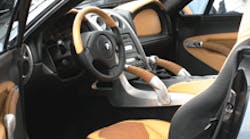Authored by: Key points: • Rapid-prototyping materials can now handle significant levels of pressure and temperature to serve in applications that demand high levels of performance. Resources: |
Last year, 13 major U. S. suppliers to the auto industry either went bankrupt or had their assets foreclosed. The Original Equipment Suppliers Association says its members see things improving somewhat, but they still have a predilection to downsize and cut costs.
In such an environment, rapid-prototyping techniques are gaining new respect as a way of fabricating parts that do double duty: serving as functional prototypes for trying out concepts and, in some cases, being tough enough to work as production parts. Moreover, OEMs increasingly find that additive-prototyping methods such as stereolithography (SLA) make it possible to devise limited-run parts that would have been uneconomical to produce otherwise.
Parts made for the new Abruzzi from the Panoz Auto Development Co., Hoschton, Ga., are prime examples. Panoz will only build 81 Abruzzis, each commemorating a past 24 Hours of Le Mans race. The final car will be produced to commemorate the 2013 race. Among the 600-hp car’s features are exotic ducting used to direct air to a radiator and two other heat exchangers for reducing coolant temperature.
Engineers at the company designed the Abruzzi using Unigraphics CAD software. STL files generated from the resulting CAD 3D models went to Solid Concepts, Valencia, Calif., a service organization for rapid-production techniques and prototyping. Solid Concepts made components for the Abruzzi via a Selective Laser Sintering (SLS) process, which uses a laser to selectively sinter (heat and fuse) a powdered material such as nylon into three-dimensional parts, one thin layer at a time
Turnaround time for the Abruzzi parts was four days. Parts created using SLS can be made from a range of materials, including nylon-11 and nylon-12 polyamides, or nylons with fillers such as glass beads, Aramid or carbon fibers (for better physical properties), and a variety of other metals. Depending on the material, SLS parts can have up to 100% density with physical properties comparable to those made with traditional manufacturing methods. The only exceptions were the curved window drop rails, hood louvers, and rear-hatch louvers, which were produced as aluminum-filled parts for sturdiness.
Traditional methods of making parts didn’t really work for the Abruzzi. “The only alternative would have been to do something out of fiberglass,” says Panoz chief engineer John Leverett. “We have looked at our volumes to see if reaction injection-molded tooling is practical. But the car has such a short run that it probably makes more sense to stick with the Solid Concepts method.”
Leverett says several SLS parts originally made for a photo shoot of the Abruzzi shell will likely end up on the production car. The shell was created for the vehicle’s debut this past June, when Panoz wanted to release photos of the car, rather than artist’s sketches, though the car had not yet been produced.
To make the photo-shoot deadline, Panoz needed to quickly build over 50 different geometries of interior and exterior components, including nine pieces that would eventually mount together to produce the dashboard. Other interior components included the center console and armrests. “All of the components for the interior were going to be covered with either one of a variety of different leathers or Alcantara, a suedelike material used for its elegant look and durability. This meant that the color of the prototypes wouldn’t be an issue, and they wouldn’t need to be sanded or prepped in any way before use — another time savings,” explains Panoz engineer Nathan Treat.
Fast parts for a fast Porsche
For a while, the Porsche 928 was the fastest car sold in North America. It went out of production in 1995. But there is still a thriving market of 928 enthusiasts who want to soup up their rides.
That’s where 928 Motorsports LLC in Horicon, Wis., comes in. It designs, manufactures, and sells performance products for the 928 which, as you might expect, have a relatively limited market.
The firm recently created a new intake runner for the 32-valve 928 engine that will get the output up to about 900 hp. This is an SLS part made from nylon 12 GF, a nylon material filled with glass beads for better physical properties.
Because the intake runner will be made in limited quantities, “There was no cost-effective alternative for the SLS part,” explains 928 Motorsports owner Carl Fausett. “We looked at investment casting but the mold could be $15,000 or more. So the only alternative to the SLS part was to not make the part at all. It would have died in the idea stage.”
Solid Concepts made a pilot SLS part which went through destructive testing at 200°F and up to 40 psi applied six times a minute for over 13,000 cycles. The point was to gauge how much part strength would be lost because of the high temperatures.
The final intake manifold runner was built with nylon 12 CF (carbon-fiber), known for its excellent strength-to-weight ratio. The final runner weighed in at just 3.096 lb compared with an aluminum part which would have weighed about 8 lb and a glass-filled version which would weigh about 4 lb. (The original Porsche intake manifold was a one-piece casting of magnesium.)
928 Motorsports is also using Solid Concepts’ SLS parts to add holders for crankshaft sensors to older engines which have no such provisions in their aluminum castings. This lets 928 owners add electronic engine management to their wheels. One reason the SLS parts work well in this application is that they are nonmagnetic and, “We can change the design without having to change a die,” says Fausett. “We also don’t have to carry an inventory of them. That’s an advantage because it is hard to predict the market for parts like this. We might sell two or five of them, but sometimes we are surprised and sell 20.”
